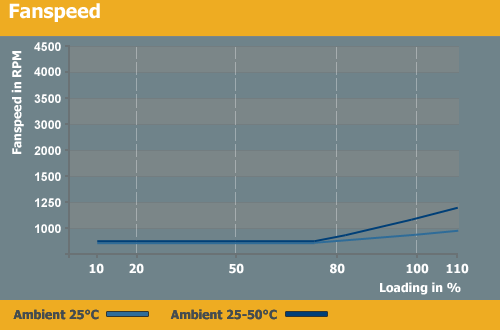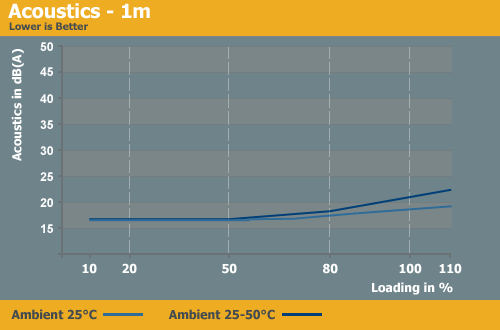Cooler Master Silent Pro PSUs
by Christoph Katzer on September 8, 2008 3:00 AM EST- Posted in
- Cases/Cooling/PSUs
Temperatures, Acoustics, and Fan Speed

The temperatures shouldn't get very high with only 500W or 600W of output power and a 140mm fan, but there are two factors at play. We have seen higher results but the Silent Pro does get relatively warm at 70°C. The exhaust temperature stops increasing with higher loads, indicating heat dissipation isn't as high as it could be. However, fan speeds are relatively low even at maximum load and temperature, indicating Cooler Master has sacrificed temperatures in exchange for lower noise levels.

You can see what we were just discussing when looking at the fan speed graph. All the way up to almost 80% load, the fan spins at its minimum speed of only 620RPM, and even then it only increases RPMs slightly up to a maximum 900RPM. Those results are for 30°C ambient temperature, but increasing the ambient temperature up to 50°C again only affects fan speed above 80% load.


With the fan staying under 1000RPM throughout testing - only exceeding that level under higher ambient temperature stress conditions - the acoustics remain very low. Some companies prefer higher fan speed and lower temperatures, but Cooler Master appears to prefer less noise. Considering most PSUs will never run at anywhere near 80% let alone 100% load, the fan speed and temperatures should be acceptable to many users - particularly those that only intend to run ~300W max power draw systems. However, lower fan RPMs mean less airflow, resulting in higher PSU and likely case temperatures, which can all contribute to earlier component failure. If you can live with that, noise levels reach a maximum of only 20dB(A) with good ambient temperature, or 23dB(A) under stress conditions. That makes this power supply a great fit for HTPCs and users looking to build "silent" PCs. We also noticed some "flickering" noise at higher RPMs, and though it didn't show up on our SPL meter it was audible when we put our ear closer to the unit.










15 Comments
View All Comments
Megaknight - Tuesday, September 9, 2008 - link
And once again the american consumer is screwed by stupid companies and the stupid US patent system...Amart - Monday, September 8, 2008 - link
The Ripple/Noise charts and a dedicated page for Quality are a good decision - thank you.OverDraught - Monday, September 8, 2008 - link
The product label does not show the UL mark, which has probably been applied for but not issued yet. No big deal unless you are in the USA and are building computers for resale or lease. If so, check with your product liability carrier before using this product.Personally, I would never by a PSU that was not UL listed.
JarredWalton - Monday, September 8, 2008 - link
As stated, the patent issues are keeping this out of the US for now, so the lack of a UL mark might have something to do with that. If/when that's resolved, then we can see if the UL is listed.Bozo Galora - Monday, September 8, 2008 - link
Well, I feel like I was just struck by lightning.Actual ripple graphs within an AT PSU review.
Beat me with a giant wet Ramen noodle.
(Anyone see pigs flying?)
semo - Monday, September 8, 2008 - link
"Cooler Master advertises their use of small copper plates on the heatsinks as a means of increasing heat dissipation, since copper transfers heat faster than aluminum. Aluminum still dissipates the heat faster to the surrounding air"so both aluminum and copper dissipate heat faster... compared to what?
also why isn't there any comarison to other psus. For example the sample reviewed here is more expansive than the CoolerMaster 520W Real Power Pro Modular but does it deserve the 50% mark up in price?
Christoph Katzer - Monday, September 8, 2008 - link
huh? yeah...Heat goes faster through copper than through aluminum. But aluminum can dissipate the heat faster into the air. This is why we have today mostly aluminum-coolers with a copper base which Cooler Master used for these power supplies now...
We do regular comparisons with the Buyer's Guide and sometimes in roundups.
For starters your mentioned unit comes from Acbel and is not even half as tough as an Enhance-build PSU like the Silentpro.
Howard - Monday, September 8, 2008 - link
I don't believe that aluminum dissipates heat faster than copper does. The reason why we have heatsinks that are a mix is probably because aluminum is much cheaper (and lighter, though that is probably a secondary rather than primary factor).bludragon - Monday, September 8, 2008 - link
I agree. I think we need mythbusters on this one. Cu has higher conductivity than Al. But, Cu is heavier, more expensive and harder to machine so we reach the compromise of Cu base and Al fins.PEJUman - Monday, September 8, 2008 - link
It's true Cu retains heat better than Al.Here are the simple clues:
Cu have higher conductivity and Specific heat than Al.
Conduction (CPU/Transistor to heatsink) needs good thermal conductivity.
Convection (Heat sink's fins to ambient air) needs a lot of surface area.
simple explaination:
While with higher conductivity, Cu will transport heat faster, but with the higher spec. heat Cu will stores more energy than Al (at the same shape and volume) while having the same surface area, thus Cu will be harder to dissipate convectively.
Now the long explaination:
Copper is a good candidate as first line 'heat sink', it will absorb a lot of energy before increasing 1 deg, meaning for a CPU at 47 deg and ambient at 27 deg, it will hold 27... 28... 29... 30 deg longer than Al as it heats up. - GOOD
now comes the drawback, with the high specific heat, when copper try to release heat to ambient air, it will maintain it's hot temperature longer than Aluminum simply because it has to dissipate more energy to ambient air before dropping 1 deg in temp.
So, let's imagine copper fins with the same shape and volume as Al, it will take a lot more air to cool the copper (not to mention it's heavier too) than the Al. - BAD
Thus the reason using Al for fins, and copper for heat block (sink).
asborbing heat from transistor or CPU got to do with small contact surface area, in which case higher thermal conductivity allows lower interface junction temp). while the Al fins dissipate heat more efficiently (in terms of heat flux/weight/size) than cooper.
Now, heat sink is just like any other overclocking quest, you're bound by the weakest link. Thus to come up with a good heatsink assembly you need to have properly sized Cu sink & Al fin.
This means sufficient surface area between the Al & Cu interface to sustain the same heat flux rate that the Cu is capable to aborb and Al fins capable to dissipate.
Mess this balance up, and your again bound by your weakest link, be it your copper block, Al fins of its Cu-Al interface area.